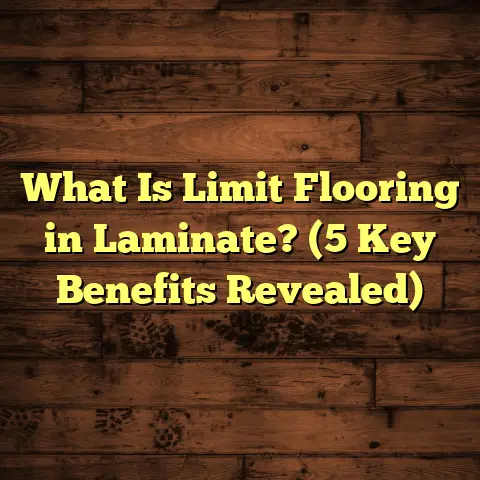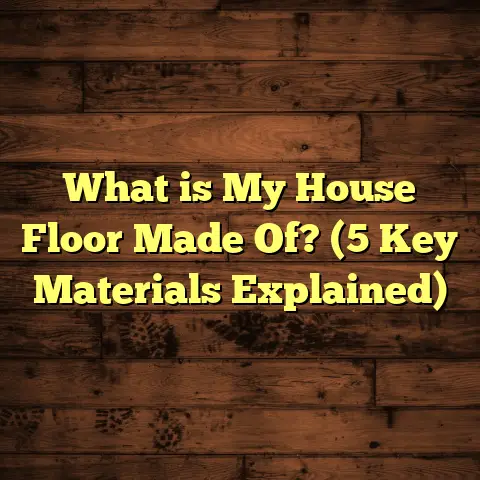What is Concrete Flooring? (5 Benefits You Didn’t Know About)
Did you know that over 60% of commercial and residential floors in the U.S. include some form of concrete flooring? That’s a huge number, especially when you consider how many types of flooring options exist today. I’ve worked with concrete floors for years, and I’m continually surprised by how versatile and durable they are. Let me share what concrete flooring really is and five surprising benefits that you might not have heard before.
What Is Concrete Flooring?
Concrete flooring is exactly what it sounds like — a floor surface made from concrete, which is a mixture of cement, water, sand, and gravel or crushed stone. When this mix hardens, it forms a very strong and solid surface that can withstand heavy use. But concrete floors aren’t just plain gray slabs; they can be polished, stained, stamped, or even dyed to look beautiful.
When I first started working with concrete floors, I thought they were just for industrial spaces or garages. But I quickly learned how they fit perfectly in modern homes, offices, retail stores, and even art galleries. Concrete is incredibly adaptable and offers a blank canvas for creative finishes.
Here’s a quick breakdown of how concrete floors come together:
- Pouring: Fresh concrete is poured onto a prepared subfloor or ground.
- Leveling: The surface is smoothed and leveled with tools like trowels.
- Curing: The concrete hardens over several days or weeks.
- Finishing: After curing, the floor can be polished, stained, or sealed.
The process may sound simple, but every step affects the final look and durability. Poorly cured or finished concrete can crack or dust over time, but well-installed concrete floors can last decades.
Types of Concrete Flooring
Concrete flooring isn’t one-size-fits-all. There are several types commonly used depending on the project:
- Raw Concrete Slab: The simplest form; often seen in garages or basements.
- Polished Concrete: A smooth, glossy finish achieved by grinding and polishing the surface.
- Stained Concrete: Adds color using acid or water-based stains to create unique designs.
- Stamped Concrete: Imprinted with patterns or textures to mimic stone, brick, or tile.
- Overlay or Microtopping: Thin layers applied over old concrete to refresh or change appearance.
I personally love working with polished and stained concrete because they offer both durability and style without needing carpets or tiles.
Benefit #1: Concrete Floors Are Surprisingly Energy Efficient
You might not think of concrete as an energy-saving material, but it actually has excellent thermal mass properties. Thermal mass means the floor can absorb heat during the day and slowly release it at night. This natural temperature regulation reduces the need for constant heating or cooling.
In one project I worked on in Minnesota, a homeowner installed polished concrete with radiant heating underneath. Over the winter months, their heating bill dropped by almost 20%. The concrete held warmth well and evenly distributed heat throughout the room.
Why does this matter? Well, houses with large open spaces or high ceilings often struggle to keep consistent temperatures without running heaters or AC non-stop. Concrete flooring helps smooth out temperature swings naturally.
How Thermal Mass Works
Thermal mass materials like concrete soak up heat when the environment is warm—say from sunlight streaming through windows—and then release that stored heat when the air cools down. This process stabilizes indoor temperatures.
This effect isn’t just theoretical; it’s backed by research. The U.S. Department of Energy highlights that buildings with high thermal mass can reduce heating and cooling loads by as much as 10-20%. That’s significant savings over time.
Practical Tips
If you’re thinking about concrete flooring for energy efficiency:
- Consider pairing it with radiant floor heating for maximum comfort.
- Use large south-facing windows to let sunlight warm the floor during winter.
- Install proper insulation beneath the slab to prevent heat loss downward.
I’ve noticed that clients who choose this combo end up loving how their homes feel cozy in winter but cool in summer without cranking up utilities.
Benefit #2: Concrete Is One of the Most Sustainable Flooring Options
Sustainability in building materials is a big topic these days — and for good reason. Concrete might not sound green at first because cement production creates CO2 emissions. But when you consider its longevity and low maintenance needs, concrete flooring often results in less environmental impact over time than hardwood or vinyl.
I recently consulted on a commercial space that replaced worn-out carpet with sealed concrete floors. The building reduced waste because they didn’t have to remove old flooring completely — the concrete slab was already there! Plus, the new floor won’t need replacement for decades, cutting down on landfill waste.
Carbon Footprint and Lifecycle Analysis
It’s true that cement manufacturing emits around 7% of global CO2 emissions. But lifecycle assessments show that because concrete floors last 30-40 years or more without replacement—and require minimal maintenance—the total environmental impact per year can be lower than other materials.
For example:
- Hardwood floors typically last 20-30 years but may require refinishing every 7-10 years.
- Carpet often needs replacing every 5-10 years due to wear.
- Vinyl and laminate have shorter lifespans (10-15 years).
Because concrete floors remain durable and functional for decades without needing replacement or refinishing chemicals, their cumulative environmental burden is reduced.
Use of Recycled Materials
Many manufacturers now offer “green” concrete mixes that include recycled aggregates like crushed glass or reclaimed concrete. Some mixes use fly ash—a byproduct of coal plants—to replace part of the cement content, lowering emissions further.
I worked on a project where we used recycled-content concrete for a new office lobby floor. The client appreciated knowing their flooring choice helped divert waste from landfills.
Waste Reduction During Installation
Concrete flooring often involves pouring directly onto an existing slab or subfloor, eliminating the need for demolition of old flooring layers. This saves money and landfill space.
In residential projects where old carpet or vinyl covers existing slabs, removing those layers isn’t always necessary if the slab can be polished or coated directly. In my experience, this shortcut reduces project time and material waste.
Benefit #3: Concrete Flooring Can Be Customized With Endless Design Options
If you think concrete floors are dull and gray, think again. I’ve helped clients create floors that look like marble, wood planks, or even colorful mosaics using techniques such as acid staining, stamping, and polishing.
For example, one restaurant I worked with used a stained and polished concrete floor with a custom logo embedded right into the entryway. It created a unique branding element that guests loved. The floor was easy to clean but also made a big design statement.
Popular Decorative Techniques
Here are some creative ways to customize concrete floors:
- Acid Staining: Chemical reactions create variegated colors with translucent effects.
- Water-Based Stains: Provide solid vibrant colors without etching the surface.
- Polishing: Multiple grinding passes gradually smooth the surface to a glossy finish.
- Stamping: Press patterns into fresh concrete to mimic brick, slate, or tile.
- Dyes: Brighten surfaces with penetrating pigments for bold looks.
- Inlays: Embed glass chips or metal strips for artistic accents.
I once did a polished concrete kitchen floor with large geometric patterns formed by saw cuts filled with colored epoxy resin. The client loved how it combined modern art vibes with home comfort.
Durability Meets Style
Unlike carpet or hardwood that can scratch or stain easily, decorative concrete stays looking great even in high traffic areas like restaurants, retail stores, or busy family homes.
Plus, sealed decorative finishes resist spills from wine, oils, or even pet accidents — making cleanup simple.
Resale Value Impact
In my experience working with real estate agents, homes with stylish polished or stained concrete floors often attract buyers who appreciate modern design combined with easy upkeep — sometimes leading to faster sales.
Benefit #4: It’s Extremely Durable and Low Maintenance
Concrete floors can take a beating without showing wear. In facilities like warehouses or hospitals where heavy equipment and foot traffic are constant, concrete holds up better than most materials.
From my experience working on industrial sites, concrete floors rarely need repairs aside from occasional resealing every few years. They resist stains if sealed properly and are less prone to dents or scratches compared to hardwood or tile.
Here’s a quick stat: properly maintained polished concrete floors can last 40 years or longer — far exceeding the lifespan of carpet (5-10 years) or vinyl (10-15 years).
Real-Life Durability Examples
I worked on a warehouse project once where forklifts drove over polished concrete floors daily for eight years straight. The floor showed almost no wear marks at all except faint scuffs easily cleaned off.
Another job involved a hospital where hygiene standards were strict. The maintenance team reported that sealed concrete floors resisted chemical cleaners and didn’t harbor bacteria like some vinyl options did.
Maintenance Made Simple
Routine care for sealed concrete typically involves:
- Sweeping or dust mopping daily to remove grit.
- Damp mopping weekly with neutral cleaner.
- Resealing every 2–3 years depending on wear.
- Spot treating stains promptly to avoid penetration.
Compare that to hardwood needing refinishing every decade plus careful moisture control — plus carpet requiring frequent vacuuming and deep cleaning — you see why many clients prefer the hassle-free nature of concrete.
Cost Over Time
Though installing decorative or polished concrete may cost $6-$15 per square foot initially (depending on complexity), lower maintenance expenses translate into savings over time.
For example:
| Flooring Type | Initial Cost (per sq ft) | Average Lifespan | Maintenance Frequency | Estimated 10-Year Cost |
|---|---|---|---|---|
| Carpet | $2–$5 | 5–10 years | Annual deep cleaning | $3–$7 |
| Hardwood | $6–$12 | 20–30 years | Refinishing every 7–10 years | $8–$15 |
| Vinyl | $2–$7 | 10–15 years | Occasional repairs | $3–$8 |
| Polished Concrete | $6–$15 | 30–40+ years | Resealing every 2–3 years | $6–$9 |
The low upkeep costs combined with long lifespan make concrete a smart investment.
Benefit #5: Concrete Flooring Improves Indoor Air Quality
Many people don’t realize how flooring affects indoor air quality. Materials like carpet trap dust, allergens, and moisture, which can worsen respiratory issues.
Concrete floors don’t harbor dust mites or mold because they’re non-porous once sealed properly. I’ve seen clients with allergy concerns switch from carpet to sealed concrete and notice significant improvements in their symptoms.
Plus, fewer chemicals are needed for cleaning compared to other flooring types. Just regular sweeping and occasional damp mopping keep concrete floors fresh and healthy.
How Flooring Impacts Air Quality
Indoor air quality (IAQ) depends partly on what’s trapped in your flooring:
- Carpets hold dust mites, pet dander, pollen.
- Vinyl flooring can emit volatile organic compounds (VOCs) if low-quality.
- Hardwood may trap moisture beneath finish causing mold growth if not maintained well.
Concrete’s sealed surface prevents particles from lodging in cracks or fibers. It doesn’t off-gas VOCs when properly cured and sealed either.
Case Study: Allergy Relief After Flooring Change
I worked with a family whose young child had severe asthma exacerbated by dust mites in carpeted bedrooms. We removed carpet and installed stained sealed concrete instead.
Within weeks, they reported fewer asthma attacks and less sneezing overall. Their pediatrician confirmed improved air quality likely contributed to better breathing conditions indoors.
Additional Things I’ve Learned From Working With Concrete Floors
Over many projects across homes and commercial spaces, here are some insights I’d like to share:
Preparation Is Everything
Concrete flooring success starts well before pouring or polishing:
- Check subfloor integrity — cracks or unevenness lead to problems later.
- Moisture testing is critical — excess moisture below slab causes failure of sealants.
- Proper curing times must be respected — rushing leads to weak surfaces prone to cracking.
One time I saw a client skip moisture testing before pouring polished concrete over an old slab in Florida humid climate. Within months cracks appeared due to vapor pressure buildup beneath surface. We had to redo much work — costly lesson learned!
Expect Some Trade-Offs
Concrete feels harder than carpet; standing all day on bare slab isn’t ideal for everyone without mats or rugs in key areas like kitchens.
Also, it can be cold underfoot unless paired with radiant heating especially in colder climates.
I suggest clients try walking barefoot on polished slabs during site visits before committing fully so they understand feel differences compared to softer options.
Cost Varies Widely by Finish Complexity
Basic raw slab finishing is cheapest but least attractive. Polishing adds cost but gains shine & durability. Staining & stamping add artistry but increase labor & material expenses too.
Budget realistically based on desired look plus installation complexities like subfloor prep.
Sealing Makes All The Difference
Proper sealing prevents dusting (concrete powdering off), enhances stain resistance, and prolongs lifespan dramatically.
There are different sealers: penetrating sealers vs topical coatings like epoxy vs urethane finishes — each suited for certain applications.
I recommend talking through pros/cons with your contractor before finalizing choices; wrong sealer choice can mean early wear & costly repairs later.
My Experience Installing Concrete Floors
I remember one project in particular that changed how I view concrete flooring’s potential. A family wanted to renovate their kitchen and living room with something durable but stylish. We chose polished concrete with a warm beige stain that mimicked limestone.
The process took about a week from prep work to finishing touches. The homeowners were thrilled not only by the look but also how cool the floor felt underfoot during summer. They mentioned it was easy to clean after their kids’ messy art projects too!
This project showed me that concrete flooring doesn’t have to feel cold or industrial — with the right treatment, it can be inviting and practical.
Another memorable job was a boutique hotel lobby where we installed stamped and stained flooring resembling aged terracotta tiles. Guests complimented the unique look that blended historic charm with modern durability. The hotel owners appreciated reduced maintenance costs compared to natural stone tiles they had before.
What You Should Know Before Installing Concrete Floors
Before deciding on concrete flooring, here are some things I always share with clients:
- Subfloor Condition: The existing slab must be stable and crack-free.
- Moisture Control: Proper sealing is critical to prevent moisture problems.
- Professional Installation: Skilled labor ensures smooth finishes without cracks.
- Comfort: Concrete can feel hard underfoot; adding rugs or radiant heat helps.
- Cost: Initial installation can vary but long-term savings often offset upfront costs.
Would you want me to help you estimate costs based on your specific space? Tools like FloorTally make it easier by considering local labor/material prices plus waste factors automatically.
Case Study: Commercial Space Saves Thousands With Concrete Floors
A local retail store switched from carpet to polished concrete across 2,000 sq ft of sales area. They spent about $12 per sq ft on installation — higher than carpet initially — but saved $1,500 annually on cleaning and maintenance costs.
Additionally, the store owners noticed customers commented positively on the modern look and feel of the space. The durability also meant no repairs even after heavy shopping days.
This case reinforced for me how concrete flooring is not just functional but also enhances customer experience.
Another example comes from an industrial facility where heavy machinery operated daily on sealed concrete floors for over 15 years without major damage—saving hundreds of thousands in floor repair costs compared to vinyl alternatives previously used there.
Frequently Asked Questions About Concrete Flooring
Q: Are concrete floors cold?
A: Yes, bare slabs can feel cold especially in winter unless paired with radiant heating systems or insulated subfloors. Area rugs also help add warmth underfoot where needed.
Q: Can I install concrete flooring myself?
A: Pouring new slabs requires skill; polishing/staining existing slabs might be DIY-friendly if you have right tools/experience but professional installation ensures best finish & durability long-term.
Q: How do I maintain polished concrete?
A: Sweep/dust mop regularly; damp mop weekly; reseal every few years depending on wear; avoid harsh chemicals that degrade sealers quickly.
Q: Is stained concrete slippery?
A: Sealed polished floors can be slippery when wet—anti-slip additives can be added during sealing to improve traction in wet areas like kitchens/bathrooms.
Q: How much does decorative concrete cost?
A: Costs vary widely; basic polished slab runs $6-$10 per sq ft while complex staining/stamping projects can go up to $15-$20+ per sq ft depending on design detail & location.
If you’re curious about whether concrete flooring suits your space, feel free to ask me! I’m happy to share more insights based on your project type and goals. Concrete flooring might just surprise you with how much it can offer beyond what meets the eye.





